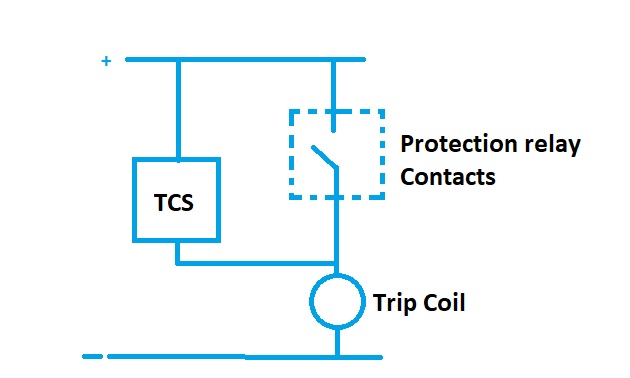The ANSI code for the trip circuit supervision relay is 95. supervision relay plays an important role in ensuring the reliable operation of circuit breakers. 95 TCS relay continuously monitors the healthiness of the trip circuit and gives an alarm if any abnormalities are detected. In this article, we will discuss the working and application of the TCS 95 relay, its purpose, and its function in power system protection.
Table of Contents

The trip circuit supervision relay is a relay that monitors the healthiness of the trip circuit and identifies any faults that could compromise the tripping operation of circuit breakers. Its primary function is to ensure that the breaker trips when a fault occurs, thus preventing damage to the system’s equipment.
Trip Circuit Supervision Relay Working
The trip circuit supervision relay (95) works on the principle of continuous monitoring of the trip circuit and the trip coil of CB. It injects a very low current of approximately 3mA into the circuit and detects any abnormality in the circuit. The below diagram shows the connection of the VAX31 95 relay

Under healthy conditions, the circuit breaker is in the closed position, and if the trip circuit gets open or the control supply fails, Relay A will drop and open contact A-1. This will lead to the de-energization of relay C, followed by relay C flag drops, and an alarm will be initiated on the alarm panel.
When the circuit breaker gets open, relay B is energized by the NC contact of the auxiliary switch of the circuit breaker. Relay C of the 95 relay is held by contact B-1 of relay B and will monitor the circuit’s healthiness in a similar way as relay “A” monitors when the circuit breaker is in the closed position.
Benefits of TCS 95 Relay
The TCS relay provides several benefits that make it an important relay in power system protection. it ensures the reliability of the Trip circuit of circuit breakers by continuously monitoring the trip circuitry and detecting any faults or abnormalities. This early detection and response help prevent serious damage to the electrical system and verify that the circuit breaker operates as intended during fault conditions.
the 95 relays can detect various faults such as open trip circuits, or wiring errors, and Control supply failure.
Function of Trip Circuit Supervision Relay
The TCS relay is used in various applications where circuit breaker tripping is vital. It is used to monitor the tripping circuit wiring from the positive supply to the negative supply in both states of the circuit breaker. It is also used to give an alarm in case of the trip circuit’s unhealthiness and also monitor the trip coil’s condition.
The TCS 95 relay is important when there is only one tripping coil. In such cases, the trip circuit’s supervision function becomes critical to ensure that the circuit breaker trips when a fault occurs.
Conclusion
The trip circuit supervision relay is an essential device in power system protection that ensures the reliable operation of circuit breakers. It is also depicted with ANSI code 95 in the panel wiring diagram.
It’s continuous monitoring of the trip circuitry and prompt detection of faults and abnormalities help prevent serious damage to the electrical system and avoid unwanted power outages.
The TCS relay’s benefits, including its ability to detect various faults, monitor the trip coil’s condition, and give an alarm in case of trip circuit unhealthiness, make it an indispensable component in power system protection.